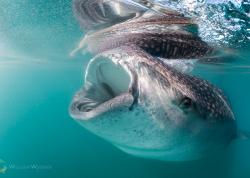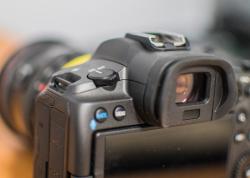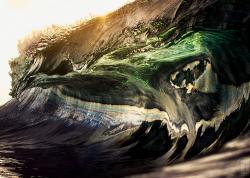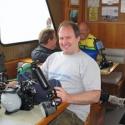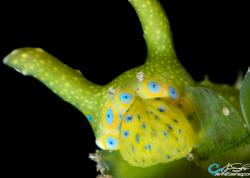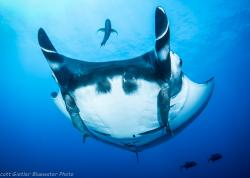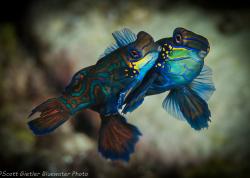Supermacro with the New SubSee Wet Diopter
A couple of weeks ago, just before the birth of my first baby, I got in 3 local dives using the new Subsee diopters and dual-flip adapter. In this article I want to share some underwater photos, tips, and thoughts on this setup. Although I was using a Nikon D300, Nikon 105mm VR lens, and the Subsee setup, this article can apply to compact camera setups using other wet diopters as well, such as the excellent Dyron macro lenses or Inon macro lenses.

Serpellid worm. F22, 1/250th, ISO 250. All photos were taken during the same day in January 2011 in Palos Verdes, Southern California with a Nikon D300, Sea & Sea housing, Nikon 105mm VR lens
Subsee diopter setup
My Subsee setup consists of 2 wet diopters of two different strengths, +5 & +10, and a custom 2-diopter flip adapter. Each adapter is custom made to fit the underwater housing port you are using. Most people get an adapter that holds one diopter, but I opted for one that holds 2 diopters.
I also used a new Sola 600 focus light, supplied by Bluewater Photo, which was incredible in helping me achieve focus, and approach shy critters.
Reflections on the Subsee diopter + adapter setup
Image Quality - the new Subsee diopters are larger and heavier, and can support full-frame cameras. I felt the quality was excellent and did not notice as much corner blurring that I had noticed in the older, smaller version of their +10 diopter.
Flexibility - I really enjoyed having the option to use the +5 or +10 diopter underwater. They really do not overlap, and for a given composition you have in mind only one or the other diopter will be appropriate. The +5 diopter gave me about 40-50% magnification, and the +10 at least 100% magnification, quite a difference. For many subjects, the +10 is "too much" and you want to use a +5.
Convenience - Being able to quickly flip the diopter back and forth was quite convenient, especially when I saw a skittish fish that I wanted to shoot with my 105mm lens alone, without a diopter.
Weight - this is quite a heavy setup. Although I was able to do three dives with it, my arms were tired, and this system will need a good amount of additional buoyancy for the next time that I take it out. My previous single-diopter setup (with the smaller older version of the diopter) was much lighter.
Achieving focus - with a 105mm lens and a strong diopter, it can be difficult to achieve focus properly. The Sola 600 focus light in wide white-light mode was amazing, and allowed me to quickly locate the subject and achieve focus, even in the dark conditions we experienced that day.
Correct positioning - I was usually able to position the diopters and strobes where I wanted them. Sometimes the strobe would be snug against the unused diopter for front lighting. I found that the best position was having the diopters at the 10 o'clock and 2 o'clock position, like in the photographs.
Build Quality - The diopters and the adapter are built very well, with excellent build quality. The diopters come with 67mm thread mounts, and protective covers for each side. One complaint is the metal screws that like to dig into the sides of my port and the diopters - I'll need to replace these with more gentle nylon screws.
Black-eyed goby. F16, 1/250th, ISO 250th, no diopter
Knob on a knobby starfish. F25, 1/250th, ISO 500, +10 diopter
Underwater photography tips when using a wet diopter
Obviously, try to choose dive sites that are known for having macro subjects and small critters. If you don't find suitable subjects, try shooting an abstract closeup of an anemone, starfish, or other common subject that will give a fresh look from a supermacro perspective.
Surge is not your friend. Try to find areas known to be less surgy, or dive deep enough so that you escape the surge. Long period swells can cause heavy surge, short period swells usually have little effect down deep.
You want to be stable underwater, so make you are properly weighted, which means slightly negatively buoyant. You don't want to be floating up or be lifted up from the bottom because of surge or current.
For additional stability, hold your port from underneath with your left hand, with your left elbow on the ground if you are in sand or rubble. Speaking of the bottom, try to find subjects that are near an area of sand or rubble you can position yourself in without harming the environment. Do not attempt to photograph subjects that have live sea fans, coral, etc. near them that can be harmed. Let me re-emphasize - for supermacro, you will have to pass up many subjects because they can not be safely photographed without harming the marine life around them.
Use a strong, even focus light like the Sola 600. The Sola 600 also has a special "red light mode" that helps not scare away shy critters. A strong focus light is essential to avoid "focus lock frustration".
Supermacro Settings - play around with your f-stop, F18 to F32 will usually give best results for a dSLR user, F8 or higher for a compact user. Shutter speed doesn't matter, I set mine to 1/250th. For cameras with large sensors, I found that changing ISO can be a quick way to get the exposure that I was looking for. Use your histogram.
Different people have different preferences for which focus mode they use - single-shot focus mode, continuous focus, or manual focusing. I prefer to use my D300 in "C" mode, continuous focus, for this setup. I move my focus point around, press the shutter half-way, and when the subject is in focus I release the shutter.
Your setup will be much easier to use if it is slightly negatively buoyant, not too heavy and not too light.
I prefer longer focal lengths, such as 100mm or 105mm, for wet diopters because of the longer working distance. This is on a cropped sensor dSLR camera. Remember that the diopter will reduce that working distance. If you are a compact camera user, this means you will want to zoom in your lens to 105mm to 150mm focal length (35mm equivalent).
Be sure to play around with direct front-lighting, and side-lighting for supermacro subjects. Using snoots underwater and ring flashes can also give excellent results.
Dark, rainy conditions like I had on my 3 dives is good for macro - it brings out the critters!

Eyes of a coonstripe shrimp. F22, 1/250th, ISO 400, +10 diopter
Feeding Polyps of a gorgonian sea fan. F22, 1/250th, ISO 400, +5 diopter
Christmas tree worm. F20, 1/250th, ISO 320, +5 diopter

Spanish shawl nudibranch rhinophores. F25, 1/250th, ISO 200, Subsee +10 diopter

Eye of a two-spot octopus. F29, 1/250th, ISO 400. Subsee +5 diopter.
Subsee & Sola Light - best way to purchase
Contact Scott, Craig or Mark at Bluewater Photo to discuss which Subsee or Sola light options are best for you, and to place an order.
Further Reading
Learning Super Macro Photography in the PNG
Guide to using a teleconverter in your underwater macro photography
Guide to supermacro underwater photography
Review of the original Subsee diopter
Supermacro winners - Ocean Art Photo Competition 2010
RECOMMENDED ARTICLES
SUPPORT THE UNDERWATER PHOTOGRAPHY GUIDE:
The Best Service & Prices on u/w Photo Gear
 Visit Bluewater Photo & Video for all your underwater photography and video gear. Click, or call the team at (310) 633-5052 for expert advice!
Visit Bluewater Photo & Video for all your underwater photography and video gear. Click, or call the team at (310) 633-5052 for expert advice!
The Best Pricing, Service & Expert Advice to Book your Dive Trips
 Bluewater Travel is your full-service scuba travel agency. Let our expert advisers plan and book your next dive vacation. Run by divers, for divers.
Bluewater Travel is your full-service scuba travel agency. Let our expert advisers plan and book your next dive vacation. Run by divers, for divers.











